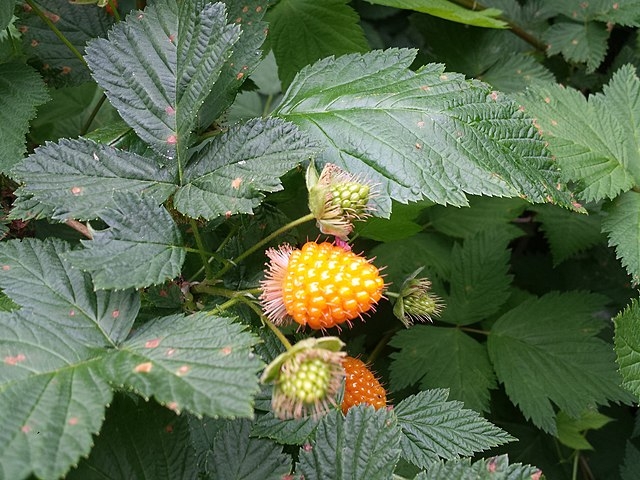Salmonberry
(Rubus spectabilis)
Salmonberry (Rubus spectabilis)
/
/

brewbooks
CC BY-SA 2.0
Image By:
brewbooks
Recorded By:
Copyright:
CC BY-SA 2.0
Copyright Notice:
Photo by: brewbooks | License Type: CC BY-SA 2.0 | License URL: https://creativecommons.org/licenses/by-sa/2.0 | Uploader: Josve05a | Publisher: Wikimedia Commons |





























Estimated Native Range
Summary
Rubus spectabilis, commonly known as Salmonberry, is a deciduous shrub native to moist coastal forests, streambanks, and wetlands along the west coast of North America, from west-central Alaska to California, and extending inland as far as Idaho. It typically grows 3 to 6 feet (1 to 2 meters) in height and 2 to 4 feet (0.6 to 1.2 meters) in width. Salmonberry has a sprawling form with prickly stems, and it produces showy pink flowers in early spring, followed by edible fruit that ranges from yellow-orange to reddish-purple in color, resembling raspberries in appearance and structure.
Salmonberry is valued for its attractive flowers, edible fruit, and wildlife habitat benefits. It is often used for streambank stabilization due to its robust root system and is also planted in native plant gardens and naturalized areas. In cultivation, it prefers moist, well-drained, nitrogen-rich soils and thrives in partial to full shade. While it is relatively low-maintenance, it can spread aggressively by root suckers, which may require management in garden settings. Salmonberry is not commonly associated with significant diseases or pests, but it can become invasive outside of its native range, so gardeners should be cautious about planting it in non-native areas.CC BY-SA 4.0
Salmonberry is valued for its attractive flowers, edible fruit, and wildlife habitat benefits. It is often used for streambank stabilization due to its robust root system and is also planted in native plant gardens and naturalized areas. In cultivation, it prefers moist, well-drained, nitrogen-rich soils and thrives in partial to full shade. While it is relatively low-maintenance, it can spread aggressively by root suckers, which may require management in garden settings. Salmonberry is not commonly associated with significant diseases or pests, but it can become invasive outside of its native range, so gardeners should be cautious about planting it in non-native areas.CC BY-SA 4.0
Plant Description
- Plant Type: Shrub
- Height: 4-8 feet
- Width: 3-6 feet
- Growth Rate: Moderate
- Flower Color: Pink
- Flowering Season: Spring
- Leaf Retention: Deciduous
Growth Requirements
- Sun: Full Sun, Part Shade, Full Shade
- Water: Medium
- Drainage: Medium
Common Uses
Bank Stabilization, Bee Garden, Bird Garden, Border Plant, Butterfly Garden, Deer Resistant, Edible*Disclaimer: Easyscape's listed plant edibility is for informational use. Always verify the safety and proper identification of any plant before consumption., Erosion Control, Hummingbird Garden, Low Maintenance, Showy Flowers
Natural Habitat
Moist coastal forests, streambanks, and wetlands
Other Names
Common Names:
Scientific Names: , Rubus spectabilis, Rubus spectabilis var. spectabilis, Rubus menziesii, Rubus stenopetalus,
GBIF Accepted Name: Rubus spectabilis Pursh